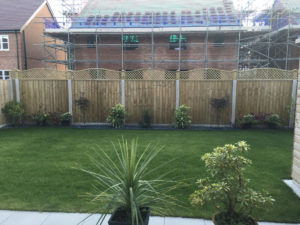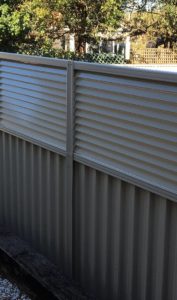You’ve chosen the perfect fence for your property, however, there is only one problem. It’s not the ideal height you were after.
The good news is that fences can actually be extended without compromising the construction or style of your current fence. More importantly, a fence extension will save you the time and expense of erecting a completely new fence. Extensions can also enhance the look of your current fence, for example, with different types of timber, Colorbond sheeting and latticework or creative panelling. Here are some great fence extension ideas to inspire you to get the job done!
Benefits of adding a fence extension
There are three main reasons people invest in a fence-topping solution:
- Privacy. Whether you have overly-nosy neighbours or they have decided to add a second storey to their home, fence extensions can add the right amount of height to ensure you are getting an adequate amount of privacy.
- Security. Fence extensions can substantially enhance the security of your home, deterring intruders from accessing your property. They can also ensure your neighbour’s large and overly inquisitive dog isn’t tempted to check out your yard.
- Aesthetics. Fences aren’t just a practical feature of your property, they can also add valuable aesthetics that may increase the value of your home if you decide to sell in the future. There are a range of screens, latticework, block-style toppers in a variety of different colours available … the only limit to the design is your own imagination!
Fence extension ideas
Image from Pinterest
Constructing a fence from timber is a great way of enhancing its “natural” aesthetics, and here, the choice of a lighter colour ensures a subtle effect allowing the vibrancy of the garden to stand out. The timber for the extension has also been chosen to complement the existing fence, and the slatted effect allows for light to penetrate the yard while still maintaining the privacy factor.
Image from DesignFlow
This is a beautiful example of a modern, contemporary fence that pairs back seamlessly with the clean lines of the deck and roofing. It’s also a great combination of muted tones that highlights the lush greenery and the base colour of the fence itself complements the brickwork of the neighbouring home’s exterior. The vertical lines add texture, and of course, we can’t ignore the most impactful feature of this fence. It’s intricate, creative and unique extension design ups the “look at me” factor!
Image from Team Work Fencing
This is a clever example of how to make a fence taller without spoiling its appearance. The base colour palette is muted and modern, and being Colorbond fencing, it is termite-proof, fireproof, corrosion-resistant and easy to clean. Because it is a modular system, it also means adding the extension would have been hassle-free, and its combination of horizontal and vertical lines and latticed top ensures it is anything but boring.
This fence has a definite “hand constructed” feel to it adding a traditional touch to this leafy backyard. The choice of blonde coloured timber exudes a light and airy feel, although the solid posts and post caps ensure it maintains a sturdy appearance. And the lattice fence extension at the top is a creative way of giving this fence a unique and charming personality.
Image from Rain And Pine
There is no doubt the owners of this property were intent on building a fence that enhanced the garden as a private oasis. They’ve definitely made a statement in terms of wanting to avoid nosy neighbours! Its handmade look is aesthetically pleasing with the vertical and horizontal panels and contrasting colour tones, and its somewhat “unfinished” appearance allows the natural grain of the timber to take centre stage.
Image from eBay
This is another lovely example of the use of timber fencing to create a backyard focal point. Colour-wise it is muted yet visually interesting with the grain of the wood giving it a beautiful textured appearance. Contrasting fence posts break up its uniformity, as does the addition of the lattice extensions that are finished in a calming, curved design
Image from Fads Fencing
In terms of backyard privacy fence extension ideas, Colorbond fencing is an ideal option for those wanting a modern, fuss-free alternative to timber. Strong, durable and available in a range of colours, this property’s owners have chosen a neutral tone that complements the brickwork and gravel paving. Vertical lines enhance the appearance of height and the lattice extension gives it an eye-catching finish.
Image from Colorbond Fence Extensions
This is another great example of the variety of designs available with Colorbond fencing. It exudes a feeling of modernity and subtlety, without being overbearing. The vertical lines at the bottom give it a sturdy appearance, with the horizontal “louvred” extension creating visual interest. The choice of a darker matte grey also enhances the privacy factor, keeping this property well and truly protected from prying eyes!
Image from Perth Screening Solutions
This fence offers privacy with its solid appearance and vertical “corrugated” panels. Colour-wise it is subtle and muted, with a slightly different tone on the perimeter of the lattice extension to give it some visual interest. The “peek-a-boo” latticework also adds texture and a creative edge to what would otherwise be a fence with minimal personality.
How to add a fence extension
You have two main options when it comes to adding a fence extension — DIY it or engage a professional to do it for you. Most household hardware retailers will sell fence extension kits, typically of the Colorbond brand.
If you decide to hire a professional, it’s worth asking them a number of questions, including:
- Are you licensed and qualified?
- Are you insured?
- How long will the job take?
- Can you provide a written quote?
- What warranty do your products come with?
- Do you have references I can follow up on?
- Can I see examples of your work?
Budgeting for a fence extension
A range of factors will impact the final cost of a fence extension, specifically:
- The type of material you choose.
- If the material you choose requires treatment like staining or painting.
- The height of the fence (standard heights include: 0.9 metres, 1.2 metres, 1.5 metres,
- 1.8 metres and 2.1 metres).
- The amount of materials required (longer runs can work out to be cheaper).
- How easy your property is to access.
- If you require scaffolding (for high fence extensions).
The price of installation will vary depending on the size of the fence, the terrain and other factors. On average, you can expect to pay anywhere from $48 per linear metre to $75 per linear metre for professional installation.
Local council laws
You may need permission to put up a fence extension on your property, so you should research the regulations that apply to where you live as they can differ by local council. There are also state-specific rules around who pays for a shared fence, its maximum size and how to deal with a boundary dispute. If your fence height extensions are above a certain height — typically two metres — you may need a building permit.
The best way of avoiding a fencing dispute with your neighbour is to include them from day one when you start planning it. Talking through all the relevant details will allow them to raise any concerns, discuss your mutual responsibilities and comply with the relevant legal requirements. And who knows — they may even offer to contribute to the cost as well!
References
- Rob Schneider, 2019, Fencing Extensions – Everything You Need to Know, hipages









